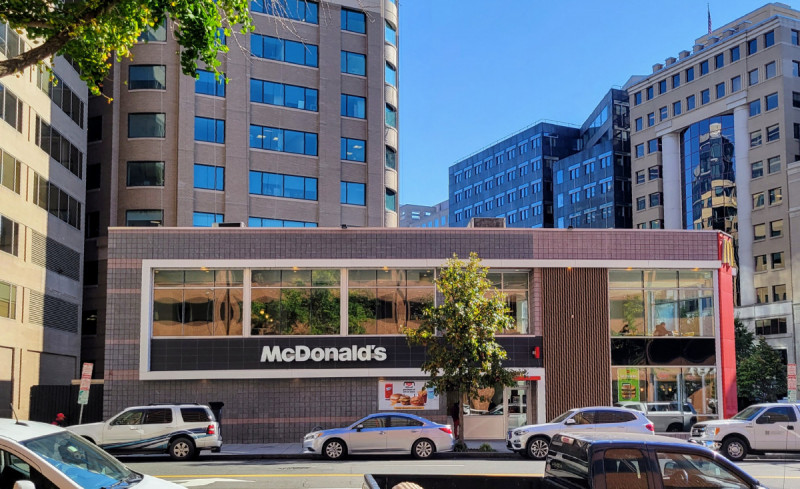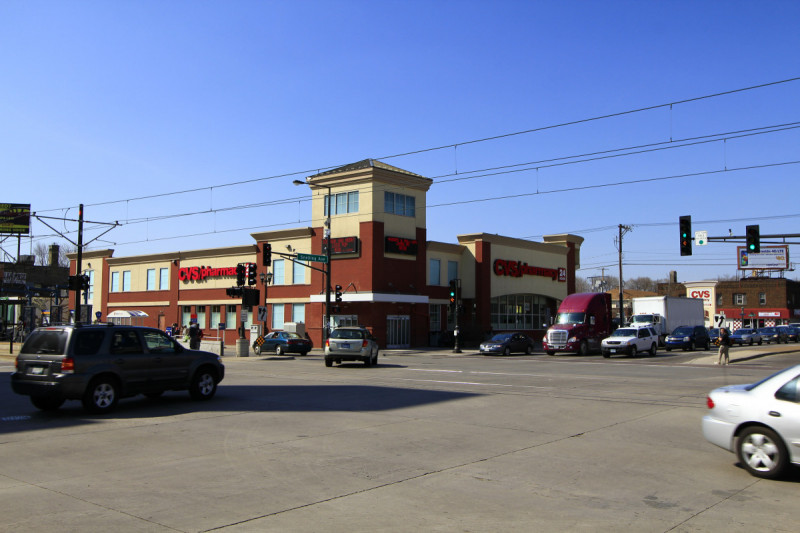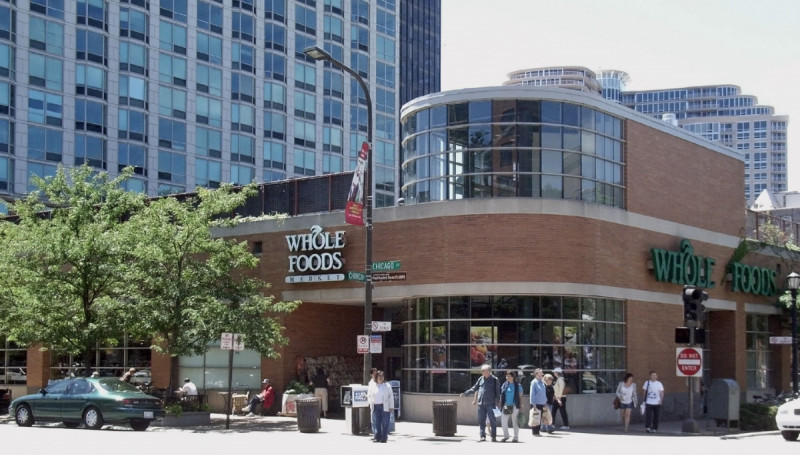What’s the deal with single-tenant retail buildings?

A low-rise McDonald’s is surrounded by high-rise office buildings near DC's Metro Center. Image by the author.
Even the densest of local neighborhoods have single-story buildings occupied by a single national chain retailer, often with an incongruous surface parking lot out front. Whether it’s a cluster of fast food boxes on New York Avenue, a supermarket in Georgetown, an auto parts store behind a streetcar stop, or an entire suburban commercial corridor, city dwellers often puzzle over these stubby structures. Surely a taller, denser, mixed-use building would be a higher-value and better use of scarce urban land?
Yet despite thoughtful GGWash articles asking for something else, single-story retail buildings stubbornly hold on in many prominent locations, and sometimes even multiply.
A CVS store, located at 6th and Pennsylvania Ave SE. Image by Andrew DeFrank.
Surprisingly, a freestanding chain store can often be the highest-value use of a piece of land. That’s because commercial real estate investors in the U.S. offer favorable terms to owners and tenants of these ubiquitous retail boxes, making them more lucrative than other buildings.
Why freestanding chain stores are super valuable
Freestanding chain stores have access to a particularly generous pool of real estate investment dollars: “net lease” investors.
Most of these buildings are leased by the retailer under what’s called a “triple net lease” (sometimes abbreviated NNN). That means the retailer pays not only rent but also all of the building’s expenses: property taxes, insurance, maintenance, and utilities. A net-lease landlord just collects rent checks every month, without any repairs to worry about. If the tenant is a financially strong corporation on a decades-long lease, there are no delinquent bills or leasing decisions, either.
That’s an attractive proposition, akin to owning a corporate bond – except even better, because it can be combined with federal income tax advantages available to landlords, such as depreciation and capital-gains-tax deferrals. The purchase price can also be financed with a mortgage paid out of the rental income. Therefore, a lot of people are willing to invest a lot of money into net-leased buildings.
Net lease investors include some big corporations, including over a dozen publicly traded real estate investment trusts with billion-dollar-plus valuations. However, the core of the net lease investor universe are individuals: wealthy retirees, well-paid professionals, or small business owners who want tax-favored investment income.
A bog-standard single-story CVS along a light rail line in Minnesota. Image by Michael Hicks licensed under Creative Commons.
Because there is such a wide bidding pool of investors who want to own easy-to-run, low-risk net leased assets, these assets fetch higher prices on the market than other properties. Brokers specializing in “net lease” transactions report that in 2020, standalone CVS stores on long-term leases sold for an average of a 5.5 “cap rate.” (As with many other investments, net lease investments have been impacted since 2020 by fast-rising interest rates.)
Cap rate (capitalization rate) is a common way to value business opportunities like commercial real estate; it’s comparable to the dividend yield on a stock or bond. It’s basically the percentage of the purchase price that the buyer will receive in net income per year. In the case of a typical CVS that sells for $6 million with 5.5 cap rate, the new landlord would receive net rent payments of $330,000 in the first year.
Multi-tenant properties are less valuable
A smaller building valued at a lower cap rate can out-bid a bigger building, even one that pays more in rent, that’s valued at a higher cap rate. The bigger building needs to be a lot bigger to offset the difference.
Even owning nice shopping malls filled with many (but not exclusively) chain stores is a much more complicated job for a landlord. The potential pool of buyers is much smaller, so the prices they’ll pay are lower. Later in 2020, the company that owns big malls like Fair Oaks Mall in Fairfax County was sold at a 7.2 cap rate. Less than two percentage points doesn’t sound like a huge difference, but cap rates are multiplied, not added – so the overall value is 31% less per dollar of income. For that same $330,000 in rental income, those few points would mean $1.4 million less value.
Mosaic District mixes uses both vertically and horizontally. Image by the author.
How about buildings with cool local retailers? They’re unpredictable and harder to manage, and so lenders and investors value the income from their leases at much lower prices; brokers call them “non-credit tenants” because their credit hasn’t been rated by Wall Street bond ratings agencies. As Jane Jacobs wrote in The Death and Life of Great American Cities, “for really new ideas of any kind… there is no leeway for such chancy trial, error and experimentation in the high-overhead economy of new construction.”
The same goes for mixed-use buildings: the added expense of managing multiple kinds of tenants cuts into the returns that owners receive. Instead, many developers prefer to horizontally separate uses, and even individual retailers, onto parcels that can be sold separately.
Whole Foods Market in downtown Evanston, Illinois is in a single-story building attached to, but not beneath, a high-rise. The two were built by the same developer but sold separately. Image by the author.
A net lease investor might seem to be overpaying for real estate, but consider that in 2020, companies like CVS were paying just 3.5% interest on corporate bonds. Compared to those bonds, a CVS landlord earning 5.5% is getting a good deal more income from CVS than a CVS bondholder is.
Neither company can be bothered
The flip side of the low cap rate earned by the net lease investor is that the retailer also gets to pay a lower lease price, which lowers the cost of running the store and improves its operating profitability. When combined with a long-term lease, the retailer has little incentive to re-evaluate the store’s performance until the lease comes due for renewal – and in many cases, those leases include automatic extensions.
CVS Health in particular is so vast that any one of its nearly 10,000 individual stores rarely stands out. Most of its revenue comes from health insurance or prescriptions; in 2023, just 6.3% of the corporation’s revenues came from the “front store,” which is what it calls its non-pharmacy retail business.
A parcel map shows how the Central Park shopping center in Fredericksburg is divided among many owners, including several net-lease investors. Image by the author._800_610.png)
Even the landlord isn’t usually interested in hearing about redevelopments that could make their property more valuable. Most of these landlords want steady and predictable income, not the risky and unpredictable returns that a redevelopment scheme might or might not offer. For example, a net leased drive-through bank branch in downtown Rockville is currently on the market for twice the recent price of an empty office building across the street, on a site twice as large.
What can we do?
It is technically possible to build a new structure that hovers over an operating retail store, but in practice it’s so costly that it only makes sense in the priciest locations. In one recent example in Manhattan, a mixed-use high-rise was built cantilevered over a shorter, existing store. The developer already owned the land, but the cantilever added an extra $100 in cost to every built square foot – resulting in an effective “land cost” far higher than any site in greater Washington.
Adding apartments above this existing low-rise New York City commercial building was an endeavor too expensive to replicate in greater Washington. Image by Image created using Google Street View.
Local governments could provide incentives to buy out leases, or even condemn properties to forcibly terminate leases. This might be needed to jump-start conversions of office buildings to residential; it’s not enough to have a 90% empty office building before starting construction. Local governments can also make it both more straightforward, and more lucrative, to redevelop single-use buildings by allowing mixed-use buildings by right, reducing parking requirements, and recognizing that very high-value sites will only be redeveloped when substantially higher density offers much higher values.
While we wait for apartments to someday materialize above the local CVS store, let’s keep in mind that even in the heyday of the streetcar era, multistory mixed-use buildings were the exception and not the norm along most neighborhood Main Streets. Most residential density wasn’t found on commercial streets, but instead along the more numerous side streets where apartments, rowhouses, and detached houses mingled.
While single-story retail buildings are highly visible, they’re rare in the grand scheme of things: only 4.3% of DC’s total land area is used by commercial or mixed-use buildings of any height. Contrast that to the 23% of DC’s land area that’s zoned single-family-only, and the real opportunity to add many more housing units becomes clear.
